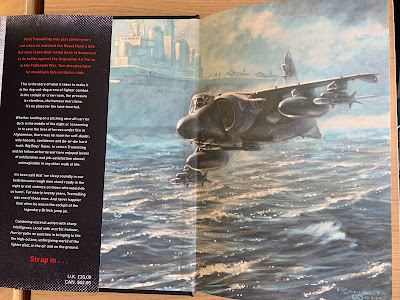Like most books on the subject, this begins with a potted autobiography about where the author came from, what lit the fires that led to him becoming a pilot and how he achieved that goal. In some recollections, this can be quite dry, though a few can be funny. However this is the first one that I have read that can genuinely be described as hilarious. The author's voice is there from the get go and his humour is spot on. I draw attention to his use of footnotes (especially page 18) and the opportunities they permit to reinforce points as well as make the reader laugh. Whilst becoming a fast jet pilot in the Royal Navy is a serious undertaking, it doesn't have to mean it's boring one and, as demonstrated here, it wasn't for Cmdr Tremelling.
The structure is pretty much chronological and neatly details the process that the author went through to reach the pinnacle of Royal Navy flying before moving to the RAF and then spending some time with the US Navy on exchange. What you'll notice with each chapter is the sub-heading, giving the reader an update as to where the author was at the time and the level of alcohol consumption undertaken. It's certainly different and adds even more character to the telling of the author's career. It's not all fun and games though, and there is a streak of seriousness that extends to the author's recollections of flying combat missions.
 |
| I do like the in-cover artwork. |
As the author was a Sea Harrier FA2 pilot, air to air combat gets covered a lot and this book will give you a much greater understanding of what that is like, especially with trips to Red Flag and dealing with the RAF's Tornado F3's. There's some gentle (and not so gentle) ribbing of others, although there is always respect where warranted. I did love the footnote on page 152 where the author comments on the Russian AA-10 Alamo C air to air missile variants as being "fruity little tinkers."
Those with an interest in combat flying will throughly enjoy this book, as will those who want to know what it was like to be a pilot in both the RN and RAF around the turn of the century - and yes, still getting used to saying that and it not referring to the beginning of the 20th century! Wargamers might get something out of this, depending on how realistic you want to make your games (and if the rules will let you do that - hint: if they don't, then change the rules to make them fit), but on the whole, this is a funny yet informative look at a period of British military aviation that begins with the improvements of the 1990's and ends with the promise (since mostly fulfilled), of a renaissance in British aircraft carrier aviation. You can buy this book at the usual places.

No comments:
Post a Comment